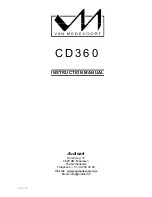
13
MAKING CONNECTIONS / SETTING UP
THE PLA
YER
ENGLISH
Video Connections
This player features S-video, composite, and component
video output possibilities.
Check the manual supplied with your TV or monitor to
determine the best possible connection for your system.
In addition to making physical connections to your TV or
monitor, it is also necessary to assign the TV screen size. You
can use the
[Setup Navigator]
in the Setup screen
General
to set whether you are using a wide screen or standard size
TV or monitor (
page 16
). Additionally, you can use the
[TV
Screen]
setting in the Setup screen
Video
menu (
page 29
).
S-VIDEO OUT
• Make S-video connections to a TV or monitor with S-video
input to produce a high quality video image.
• Use an S-video cable (not supplied) to connect the output
on the player to S-video input on the TV or monitor.
VIDEO OUT
• Make composite video connections to a standard TV or
monitor with a video input jack.
• Use the supplied video cable to connect the
VIDEO OUT
jacks on the player to the video input on the TV or monitor.
• Be sure to match the color of the plug with the color of the
jack (yellow).
TV or monitor
S-VIDEO IN
S-VIDEO
VIDEO IN
VIDEO
(yellow)
(yellow)
TV SYSTEM switch
Video output changes as follows according to the playback
disc‘s recorded format.
NTSC
=
PAL, PAL
=
NTSC conversion is possible on Video
CDs. PAL
=
NTSC conversion is not possible on DVDs.
When the
TV SYSTEM
switch is set to the
AUTO
position, the
disc’s format will be output as is. When a CD or disc is not
loaded, the previous video output format will be selected.
About MOD. (Modulation) PAL
• SHRINK
Most models of the newly developed countdown PAL TV
system detect 50 Hz (PAL)/60 Hz (NTSC) and automatically
switch vertical amplitude, resulting in a display without
vertical shrinkage.
• If your PAL TV does not have a V-Hold control, you may not
be able to view NTSC disc because the picture may roll. If
the TV has a V-Hold control, adjust it until the picture stops
rolling. On some TVs, the picture may shrink vertically,
leaving black bands at the top and bottom of the screen.
This is not a malfunction; it is caused by the NTSC
=
PAL
conversion.
Type
DVD
Video CD
CD, No disc
Format
NTSC
PAL
NTSC
PAL
Disc
Output format
Position of TV SYSTEM switch
NTSC
PAL
AUTO
NTSC
MOD. PAL
NTSC
PAL
PAL
NTSC
MOD. PAL
NTSC
NTSC
PAL
PAL
NTSC
PAL
NTSC or PAL
TV or monitor














































